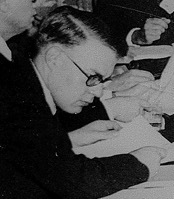Top Qs
Timeline
Chat
Perspective
Frank Kenneth Goward
Nuclear Scientist From Wikipedia, the free encyclopedia
Remove ads
Frank Kenneth Goward (1919 – March 1954) was an English scientist, specialized on aerial technologies and particle accelerator development.[1]
Remove ads
Early career
During World War II, Goward worked as a specialist on antenna technologies at the Telecommunications Research Establishment (TRE) at Malvern in England.[1] After the war had ended, the focus of his research shifted to new ways to accelerate particles. During 1946, he used a converted betatron from the American accelerator pioneer Donald William Kerst to demonstrate the first synchrotron acceleration of electrons to 8 MeV at Woolwich Arsenal.[2] After that, the machine was moved to Malvern, where it was improved further. This work culminated in October 1947, when Goward and his team managed to obtain a stable beam, thus creating the first fully operational synchrotron.[1]
Remove ads
Work for CERN
Summarize
Perspective

After TRE's research focus shifted away from synchrotron accelerators in 1950, Goward started to become interested in the idea of a joint European research facility that would focus on the peaceful exploitation of nuclear physics, which would later become CERN. Although United Kingdom (U.K.) government officials were very averse to this idea at the beginning, leading scientists of the country tried to encourage an involvement of the U. K. in this venture. Among these was John Cockcroft, who sent Goward as an observer to the first planning meetings in 1951.[3][4] At the first session of the provisional CERN council in May 1952, Goward was elected deputy director of the study group which was in charge of studies and investigations about the future Proton Synchrotron (PS), a novel accelerator that would reach energies of up to 10 GeV. The director of the study group was the Norwegian Odd Dahl.[5]
With the initial PS group, Goward developed ideas and techniques to build CERN's first synchrotron. This work got a defining boost when Goward, together with his colleagues Odd Dahl and Rolf Widerøe, visited Brookhaven National Lab in the United States. There, they learned about the newly developed alternating-gradient principle.[6] In the fall of 1953, Goward moved to Geneva permanently and became the project leader of the PS group, assembling a team to build the machine. Soon after, he became seriously ill, which forced him to return to England. He died in March 1954. John Adams, who would later become Director General of CERN, was Goward's successor as leader of the PS group.[5]
In honour of Frank Goward, a street at CERN's main campus in Meyrin is named after him. (See list of streets at CERN).
Remove ads
Further reading
- F.K. Goward and D. E. Barnes, Experimental 8 MeV Synchrotron for Electron Acceleration, Nature 158, p. 413, 1946.
- F.K Goward, Review of principles leading to design of CERN proton synchrotron, Published on CERN Document Server At the Conference on the Theory and Design of an Alternating-Gradient Proton Synchrotron, Geneva, Switzerland, 26 - 28 Oct 1953, pp. 19–43
References
Wikiwand - on
Seamless Wikipedia browsing. On steroids.
Remove ads

